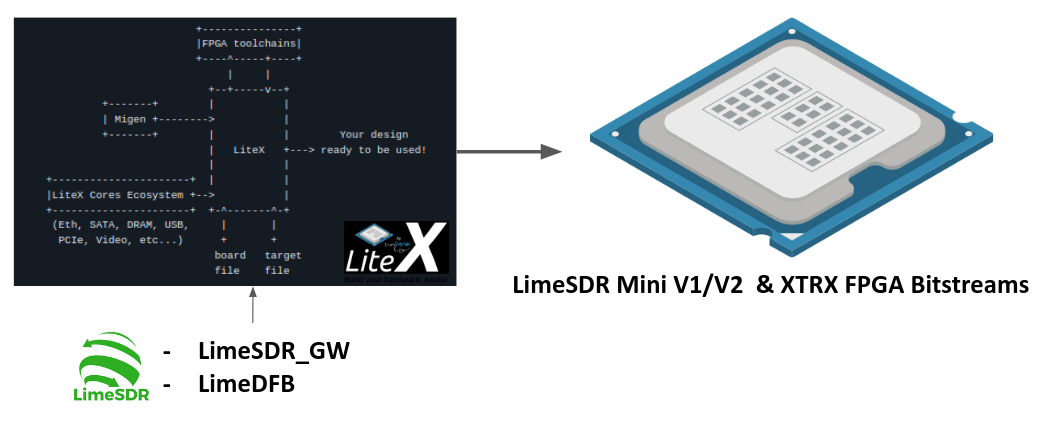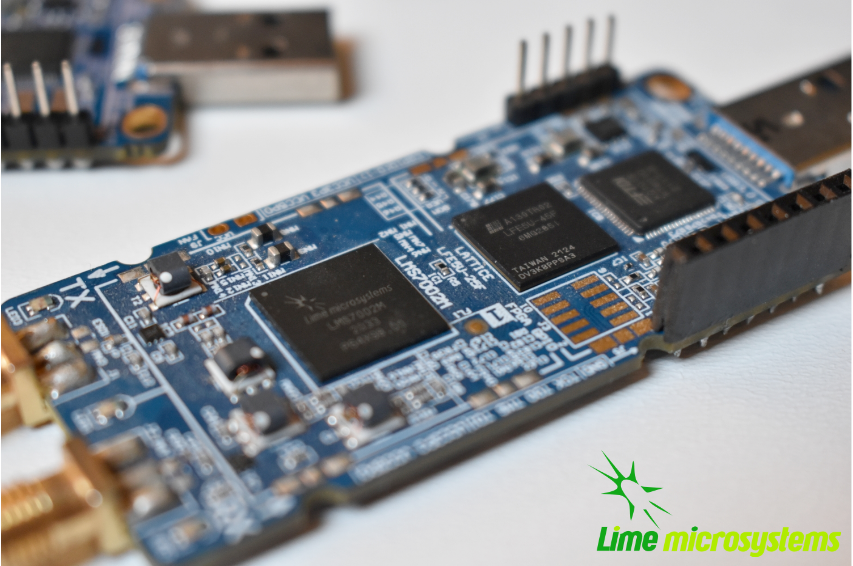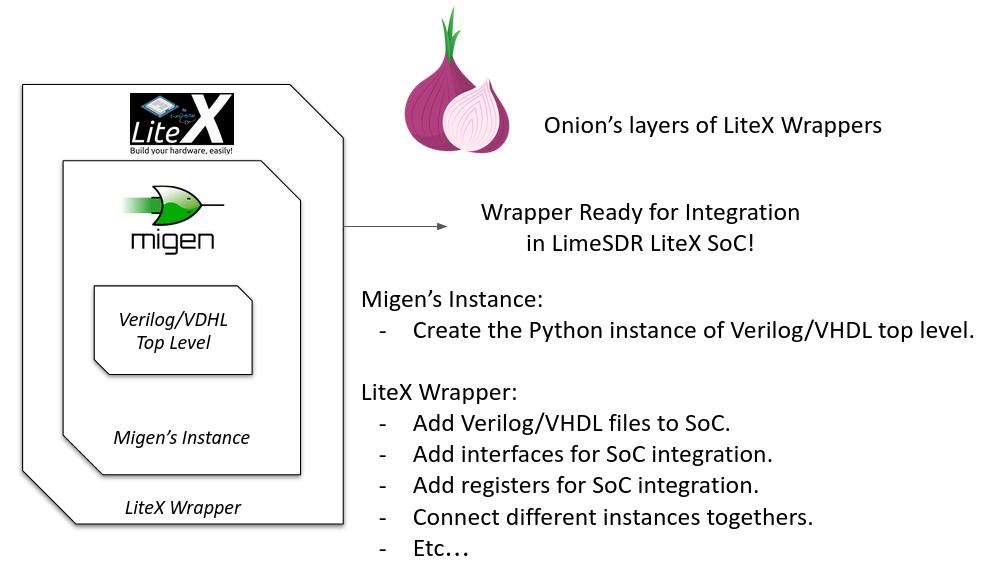LiteX Basics
Introduction to LiteX in LimeSDR_GW
This document introduces the basics of LiteX as used in the LimeSDR_GW project. It covers key concepts like platforms, targets, wrappers, naming conventions, and portability features. LiteX is central to the project, providing a flexible, vendor-neutral framework for building SoCs. If you’re new to LiteX or need to understand its integration with LimeSDR_GW and LimeDFB, this is a good starting point. For more on repository structure, see Project Structure. For advanced usage like adding boards, refer to Adding a New Board.
Overview of LiteX usage in LimeSDR_GW

LiteX is an open-source SoC builder toolkit that uses Python to define, integrate, and assemble FPGA-based systems. It automates challenging SoC components, such as bus interconnections, clock/reset management, memory allocation, CPU integration, and firmware/toolchain compilation.
Unlike traditional HDL methods or proprietary tools like Vivado’s Block Design, LiteX offers a flexible, vendor-neutral workflow that seamlessly connects hardware and software.
Core features include:
Hardware Integration: Connects modules, manages clock/reset domains, and handles system buses with minimal overhead.
CPU and Firmware Support: Supports various soft-core processors (e.g., VexRiscv, LM32) and automates firmware builds (including linker scripts and BIOS).
Toolchain Automation: Handles firmware and FPGA compilation pipelines—running synthesis, placement/routing, bitstream generation, and firmware builds with simple commands.
Vendor Neutrality: Works with Intel, Xilinx, Lattice, and others through adaptable platform definitions.
Multi-Language Support: Easily incorporates existing Verilog/VHDL components via wrappers.
The LimeSDR_GW repository uses LiteX to provide a consolidated gateware base for LimeSDR variants (e.g., Mini V1/V2, XTRX). It replaces scattered HDL projects with a systematic, sustainable LiteX-based SoC for SDR applications.
It incorporates the LimeDFB library (hosted on GitHub at myriadrf/LimeDFB), featuring modular VHDL components for RF data processing (e.g., RX/TX paths for the LMS7002M). These modules are reusable and adaptable for other RF transceivers.
Advantages of the LimeSDR_GW and LimeDFB approach include:
Reusability: Shared RF and interface components (e.g., streaming engines, LMS7002M controllers) across all boards.
Sustainability: A single, uniform architecture replaces fragmented per-board HDL branches.
Modularity: Clear separation of RF processing (LimeDFB), SoC management (LiteX), and board-specific configs (platform/target).
Expandability: Easy addition of new boards or variants by extending platform/target files, without duplicating logic.
Portability: Greater flexibility for migrating to new FPGA families or upcoming LimeSDR versions.
Collaboration: Standardized designs improve readability and reduce onboarding challenges for contributors.
This approach replaces isolated, board-specific HDL projects with a unified, scalable framework that accelerates innovation while reducing technical debt.
Benefits of Using LiteX (in the Context of LimeSDR_GW)
LiteX delivers substantial improvements to SDR gateware development within the LimeSDR_GW ecosystem:
Unified SoC Framework: Platforms like Mini V1/V2 and XTRX share a common blueprint, facilitating maintenance and consistent features across configurations.
Streamlined Board Setup: Python-based platform and target scripts quickly define clocks, pin assignments, and memory layouts, eliminating custom HDL top-level files.
Reusable Host Interfaces: PCIe and USB modules are modularized for reuse, minimizing redundant work.
Seamless Firmware Pipeline: Integrating a soft CPU (e.g., VexRiscv or PicoRV32) requires minimal Python code, with LiteX handling firmware compilation, linker files, and deployment automatically.
Fast Prototyping Cycles: Simultaneous hardware and software modifications in a single environment speed up development and debugging.
Cross-FPGA Portability: Designs can be ported to different FPGA vendors (Xilinx, Intel, Lattice) by simply updating the platform definition and making minor vendor-specific adjustments.
Open Toolchain Support: LiteX integrates with open-source FPGA tools (e.g., Yosys, Nextpnr) where possible, enabling fully transparent development workflows.
Before LiteX, LimeSDR boards used separate HDL projects dependent on vendor-specific tools. Processor choices varied: MicroBlaze for Xilinx, Nios II for Intel, and LM32 for Lattice. Each had unique firmware toolchains, memory maps, diagnostics, and flashing methods. Switching boards required adapting to different environments, hindering code sharing and debugging consistency.

The LiteX-based LimeSDR_GW overcomes this fragmentation with a shared SoC structure, standardized firmware management, and unified debugging tools. This greatly lowers barriers for adding new boards or features, making development, validation, and collaboration far more efficient.
Understanding Core LiteX Concepts: Boards, Platforms, Targets
LiteX structures FPGA designs around three key concepts: boards, platforms, and targets. Unlike traditional design flows, where these are spread across HDL source files, constraint documents (e.g., .xdc, .sdc, or .lpf), and vendor-specific project settings, LiteX centralizes them in Python scripts. This provides a portable, vendor-neutral, and toolchain-aware method for specifying systems.
This section explains each concept, using the LimeSDR Mini V2 as a real-world example.

Platform = Board + Constraints
In LiteX, the platform represents the physical hardware board and its constraints. Rather than scattering pin assignments and timing specs across separate HDL and constraint files, LiteX consolidates them into a single platform Python file (e.g., limesdr_mini_v2_platform.py).
This file includes:
Definitions for all available I/Os (clocks, SPI, I2C, LMS7002M interfaces, USB FIFO, LEDs, etc.)
Electrical characteristics (IOStandard, Misc, pull-up resistors, etc.)
Timing constraints via methods like add_period_constraint()
The FPGA device identifier
Programming interface configuration (create_programmer)
LiteX parses this file to generate suitable project and constraint files for tools like Vivado, Quartus, Diamond, or Yosys/Nextpnr.
LMS7002M I/O Block on LimeSDR Mini V2
This I/O definition specifies all signals connecting the FPGA to the LMS7002M transceiver, including control lines, RX/TX digital data paths, and clock signals:
("LMS", 0,
# Control.
Subsignal("RESET", Pins("A7")),
Subsignal("CORE_LDO_EN", Pins("C6")),
Subsignal("RXEN", Pins("D6")),
Subsignal("TXEN", Pins("B7")),
# RX Interface (LMS → FPGA).
Subsignal("DIQ1_D", Pins("J2 L1 K1 K4 G3 F4 J1 H1 G4 F2 G1 H2")),
Subsignal("TXNRX1", Pins("F1")),
Subsignal("ENABLE_IQSEL1", Pins("F3")),
Subsignal("MCLK1", Pins("H4")),
Subsignal("FCLK1", Pins("H3")),
# TX Interface (FPGA → LMS).
Subsignal("DIQ2_D", Pins("A3 C2 A2 B4 C3 B2 D3 B1 A4 C1 C7 A6")),
Subsignal("TXNRX2_or_CLK_SEL", Pins("B6")),
Subsignal("ENABLE_IQSEL2", Pins("C4")),
Subsignal("MCLK2", Pins("D2")),
Subsignal("FCLK2", Pins("D1")),
# Electrical standard.
IOStandard("LVCMOS25")
),
This method replaces the conventional spread across a main HDL wrapper and multiple .xdc/.lpf/.sdc files.
Timing Constraints Generation
Main timing constraints related to hardware oscillators are defined programmatically in the platform’s do_finalize() function:
def do_finalize(self, fragment):
self.add_period_constraint(self.lookup_request("LMK_CLK"), 1e9/40e6)
self.add_period_constraint(self.lookup_request("FT_CLK"), 1e9/100e6)
self.add_period_constraint(self.lookup_request("LMS:MCLK1"), 1e9/125e6)
self.add_period_constraint(self.lookup_request("LMS:MCLK2"), 1e9/125e6)
LiteX then translates these into the appropriate format for the selected toolchain:
.lpf for Diamond
.sdc for Nextpnr
.xdc for Vivado
.qsf and .sdc for Quartus
As created in the user design, other timing constraints can also be added in the target. Timing constraints directly derived from PLLs/MMCMs are generally automatically added by the tools if the source constraint is defined, so there is generally no need to add them manually (The approach can still depend on the toolchain and timing reports need to be verified after build).
Multiple Toolchain Support
Since LiteX uses its own IO and timing constraints definitions and supports multiple toolchains when available for the same FPGA family, switching between toolchains is simply a matter of changing the toolchain argument.
The LimeSDR Mini V2 supports both Lattice Diamond and Yosys + Nextpnr workflows:
The same Python platform file is used for both.
LiteX generates the relevant build artifacts based on the specified toolchain.
For example: - With
--toolchain=diamond→ .ldf, .lpf, VHDL-compatible sources - With--toolchain=trellis→ .json, .sdc, pcf
This enables smooth switches between proprietary and open-source toolchains without duplicating designs or constraints.
Target = SoC Top-Level + Flow Control
The target file (e.g., limesdr_mini_v2.py) serves as the main entry point. It manages:
Instantiation of the platform class
Initialization of the SoC core
Connection of peripherals, memory regions, buses, and clock domains
Integration of logic for the LMS7002M (via LimeTop), FT601 USB interface, SPI, I2C, and other components
Addition of optional features like LiteScope analyzers or UARTBone
The same file can be used to build, load, or test a bitstream with different options:
# Open-source toolchain build + load
python3 -m boards.targets.limesdr_mini_v2 --toolchain=trellis --build --load
# Diamond toolchain build + flash
python3 -m boards.targets.limesdr_mini_v2 --toolchain=diamond --build --flash
How It All Fits Together
Platform = Unified Python representation of board I/O, constraints, and flashing method
Target = Main SoC builder that handles system wiring
Toolchain files = Automatically generated based on the platform and selected toolchain
This structure supports consistent, flexible designs across various LimeSDR boards and FPGA vendors, removing the need to modify underlying HDL or constraint files.
Creating LiteX/Migen Wrappers
Many modules in the LimeDFB repository are written in VHDL and need to be instantiated and managed within LiteX’s Python-based SoC environment. This is achieved using LiteX/Migen wrappers, which define the VHDL module’s interface, connect it to the SoC bus (e.g., via CSRs), and ensure smooth inclusion in the FPGA build process.

LiteX Wrapper onion layers :): At the core is the Verilog/VHDL Top Level module (e.g., a LimeDFB block). It is first instantiated using Migen to create a Python instance of the HDL top level. The LiteX wrapper then adds portability features, such as Verilog/VHDL file inclusion in the SoC, IO connections/stream interfaces, CSR registers for firmware control, and connections to different SoC instances. This modular layering ensures seamless integration and reuse across FPGA vendors and designs.
This section shows how to create such a wrapper, using the gpio_top module as a practical example.
Example: Wrapping the GPIO Module
The GPIO module is implemented in VHDL in the file:
LimeDFB/gpio_top/src/gpio_top.vhd
To make it LiteX-compatible, a Python wrapper is created in:
gateware/gpio_top.py
This wrapper does the following:
Defines a LiteX module (GpioTop), inheriting from LiteXModule.
Specifies the interface using Signal objects, such as GPIO_DIR, GPIO_OUT_VAL, and GPIO_IN_VAL.
Creates CSRs with CSRStorage/CSRStatus to expose control and status registers to firmware.
Instantiates the VHDL module using Migen’s Instance(…), linking signals and parameters.
Adds bidirectional buffering with FPGA-specific primitives (e.g., Xilinx IOBUF).
Adds the VHDL source to the build via platform.add_source(…).
Illustrative code snippet:
class GpioTop(LiteXModule):
def __init__(self, platform, pads):
# Define internal signals for the GPIO interface (e.g., direction, output value, input value)
self.GPIO_DIR = Signal(len(pads))
self.GPIO_OUT_VAL = Signal(len(pads))
self.GPIO_IN_VAL = Signal(len(pads))
# Create CSRs to expose GPIO controls (override, direction, value) and status to firmware
self.gpio_override = CSRStorage(len(pads))
self.gpio_override_dir = CSRStorage(len(pads))
self.gpio_override_val = CSRStorage(len(pads))
self.gpio_val = CSRStatus(len(pads))
# Internal signals for bidirectional I/O buffering
self._pads = Signal(len(pads))
self.GPIO_I = Signal(len(pads))
self.GPIO_O = Signal(len(pads))
self.GPIO_T = Signal(len(pads))
# Combinatorial assignments: connect status CSR to input value and pads to internal pads signal
self.comb += [
self.gpio_val.status.eq(self.GPIO_IN_VAL),
pads.eq(self._pads),
]
# Instantiate the VHDL module using Migen's Instance, linking Python signals to VHDL ports and parameters
self.specials += Instance("gpio_top",
p_G_GPIO_WIDTH = len(pads),
i_GPIO_DIR = self.GPIO_DIR,
i_GPIO_OUT_VAL = self.GPIO_OUT_VAL,
o_GPIO_IN_VAL = self.GPIO_IN_VAL,
i_GPIO_OVERRIDE = self.gpio_override.storage,
i_GPIO_OVERRIDE_DIR = self.gpio_override_dir.storage,
i_GPIO_OVERRIDE_VAL = self.gpio_override_val.storage,
i_GPIO_I = self.GPIO_I,
o_GPIO_O = self.GPIO_O,
o_GPIO_T = self.GPIO_T
)
# Add vendor-specific bidirectional buffering (e.g., IOBUF for Xilinx) for each pad
for n in range(len(pads)):
self.specials += Instance("IOBUF",
o_O = self.GPIO_I[n],
io_IO = self._pads[n],
i_I = self.GPIO_O[n],
i_T = self.GPIO_T[n]
)
# Add the VHDL source file to the platform's build sources for synthesis
platform.add_source("./gateware/LimeDFB/gpio_top/src/gpio_top.vhd")
General Pattern
This approach applies to other LimeDFB modules or external HDL IP, as long as their interfaces are clearly defined and suitable for wrapping.
It broadly supports cores in:
VHDL
Verilog/SystemVerilog
Amaranth
SpinalHDL
Chisel
For a detailed tutorial on wrapping external cores in LiteX, see: https://github.com/enjoy-digital/litex/wiki/Reuse-a-(System)Verilog,-VHDL,-Amaranth,-Spinal-HDL,-Chisel-core
This modular, language-agnostic method allows engineers to integrate custom IP into a LiteX SoC with minimal effort, leveraging LiteX’s robust tooling and cross-platform features.